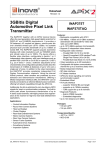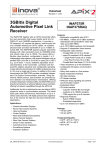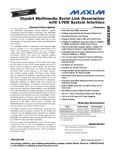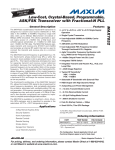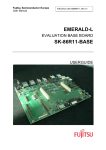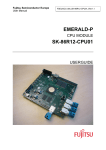Download INAP378T APIX2 Transmitter pdf, 384.5 kB
Transcript
Preliminary Datasheet Revision 0.2 3GBit/s Digital Automotive Pixel Link Transmitter The INAP378TAQ together with the INAP378RAQ receiver offers the next generation high speed digital serial link for CAMERA applications. It provides a DC-balanced, AC coupled low latency, point-to-point link over shielded twisted pair (STP) cables. Its scalable physical layer provides bandwidth of up to 3 GBit/s at lowest EMI. The INAP378TAQ supports popular automotive image sensor solutions with video resolutions such as 1280x800 pixels and refresh rates of up to 45fps. The device offers a parallel video interface for support of up to 16 color bits + 2 control bits. Software adjustable driver characteristics and configurable operating modes allow the transmission of 1.5 GBit/s at distances of up to 25m over a single pair of w ir e s. In a d d itio n to t h e vi d e o tr a n s m iss io n t h e INAP378TAQ provides completely independent Full Duplex Communication channels. Using the internal AShell protocol, data transfers are protected by error detection and retransmission mechanisms. Additionally, the link is optimized to carry low latency GPIO signals for reset or synchronization purposes. Applications: • • • • • • Round View Camera Systems Stereo Camera Systems Rear View Camera Systems Automotive Driver Assistance Surveillance Systems Inspection Systems INAP378TAQ Features: • 500 MBit/s, 1 GBit/s, 1.5 GBit/s and 3 GBit/s sustained downstream link bandwidth for video data rates up to 2591 MBit/s • up to 187.5 MBit/s upstream link bandwidth • Configurable video interface – openLDI compliant LVDS interface (18 or 24 Bit) – Parallel Bulk Data Mode (10,12,18 Bit) • Video resolutions up to HD resolutions • Full duplex AShell communication channel – Data CRC protection and correction • SPI slave interface • I²C Master interface • GPIOs for direct signalling and camera synchronization support • I²S Audio interface – supports 16/24/32 Bit word length – supports up to 192kHz sampling – TDM support for up to 8 channels • Diagnostic Features: – Built-In PRBS Generator – Embedded diagnostics • Up to 25m distance at 1.5 GBit/s Package: • 92 pin aQFN Temperature/Quality: • -40°C to +85°C • AEC-Q100 10MHz Video 1.5GBit/s I²C Sensor Sync INAP378T 187.5MBit/s Clock Figure 1: Application example DS_INAP378T Revision 0.2 Inova Semiconductors Confidential Page 1 of 26 Preliminary Datasheet 10MHz Video I²C Sensor 1.5GBit/s Sync INAP378T 187.5MBit/s I2S Audio ADC Microphone Figure 2: Application example for camera with audio 1.0 Block diagram Audio LVDS / parallel video I2S Integrity support FIFO Framer Serializer Audio FIR APIX Downstream MCLK Clock GPIO GPIOs I2C Dev. EEPROM I2C M Data Configuration SPI S Phase alignment Mux Video Deserializer Deframer I2C AShell Configuration, Control, Status Reset Osc. Reset 10MHz CML APIX Upstream VCO Figure 1-1: Block diagram DS_INAP378T Revision 0.2 Inova Semiconductors Confidential Page 2 of 26 Preliminary Datasheet 2.0 Electrical Characteristics All values in this section are based on preliminary characterization. Final values will be available after product qualification. 2.1 Absolute Maximum Ratings The absolute maximum ratings define values beyond which damage to the device may occur. Exposure to absolute maximum rating conditions for extended periods may affect device reliability. The functional operation of the device at these or any other conditions beyond the recommended operating ratings is not guaranteed. Parameter Symbol Min. Max. Units DC Supply Voltage VDVDD, VDVDD_XTAL, VAVDD_LD -0.5 5.0 V Input Voltage VVDD , VAVDD, VAVDD_LVDS, VVDD_XTAL -0.5 3.0 V ID -20 +20 mA Tstg -55 +150 °C 260 °C 40 seconds maximum RD=1.5kΩ, CS=100pF I/O Current (DC or transient any pin) Storage Temperature Max Soldering Temperature TSLD / TSLD ESD Protection HBM JEDEC JESD22/A114 -3 +3 kV ESD Protection CDM EIA/JEDEC JESD22/C101 -1 +1 kV ESD Protection MM EIA/JEDEC JESD22-A115A -200 +200 V Note Table 2-1: Absolute maximum ratings DS_INAP378T Revision 0.2 Inova Semiconductors Confidential Page 3 of 26 Preliminary Datasheet 2.2 Recommended Operating Conditions Parameter Symbol Min. Typ. Max. Units VVDD, VVDD_XTAL 1.71 1.8 1.89 V Digital IO Supply, Digital Oscillator supply VDVDD, VDVDD_XTAL 3.0 3.3 3.6 V CML PHY supply voltage, VCO supply VAVDD, VAVDD_VCO 1.71 1.8 1.89 V VAVDD_LD 1.8 3.3 3.6 V VAVDD_LVDS_PLL, VAVDD_LVDS 1.71 1.8 1.89 V Ta -40 - +105 °C Digital Core supply, Oscillator supply CML IO supply LVDS PLL & Core supply Ambient Temperature Note Table 2-2: Recommended operating conditions 2.3 Electrical Characteristics 2.3.1 Serial Interface The INAP378TAQ downstream serial interface offers a flexible serial interface, with configurable pre-emphasis and digital filter structure. Data dependent deterministic jitter components, mainly introduced by ISI due to cable attenuation, can be compensated by pre-emphasis and equalization. Therefore only periodic and random jitter components are considered. Parameter Effective serial bit rise and fall time CML Drive current Symbol Min. Typ. Max. Units trf_ser_effective 75 140 - ps Iout_dwn tbd - - mA Note Table 2-3: Downstream interface characteristics (SDOUT+, SDOUT-) Parameter Differential input voltage range Serial input common mode range Symbol Min. Max. Units Vdiff_in ± 50 ± 500 mV Vcmm_SDIN GND +0.7V + (Vdiff_in/2) VAVDD +0.5V (Vdiff_in/2) Note V Table 2-4: Upstream interface characteristics (SDIN+,SDIN-) DS_INAP378T Revision 0.2 Inova Semiconductors Confidential Page 4 of 26 Preliminary Datasheet 2.3.2 Supply Current Parameter Digital Core & Oscillator Supply current Digital IO & Oscillator Supply Current LVDS Core & PLL Supply Current CML PHY Supply Current VCO Supply Current CML IO Supply Current Symbol Typ.a Max. Unit IVDD + IVDD_XTAL 51 120 mA IDVDD + IDVDD_XTAL 3 50 mA IAVDD_LVDS + IAVDD_LVDS_PLL - 30 mA IAVDD 82 190 mA IAVDD_VCO 5 15 mA IAVDD_LD 2 95 mA Comment see Figure 2-9 see Figure 2-9 Table 2-5: Supply current a. Bulk data with 95MHz pixel clock and 5m cable settings at 1.5GBit/s DS_INAP378T Revision 0.2 Inova Semiconductors Confidential Page 5 of 26 Preliminary Datasheet 2.3.3 Pixel Interface The INAP378TAQ‘s pixel interface can be configured to parallel RGB or LVDS inputs. For further informations please refer to the INAP378TAQ user manual. 2.3.3.1 RGB Interface Parameter Description Test Condition Min. Max. Units VIH Input High Voltage 2.0 VDVDD V VIL Input Low Voltage 0 0.8 V IIH Input High Current a Vin = VDVDD -10 10 µA IIL Input Low Current a Vin = 0 V -10 10 µA VOH Output High Voltage IOH= -3mA 2.4 - V VOL Output Low Voltage IOL= 3mA - 0.4 V Table 2-6: RGB characteristics a. input with Schmitt Trigger (current feedback of ~100µA) Figure 2-1: RGB Interface Timing The capturing edge of pixel clock can be set to rising or falling. For further information please refer to the INAP378TAQ user manual. fPIXEL_CLOCK = 1/tPERIOD . All values specified for TA=25°C. Parameter Description Test Condition fPIXEL_CLOCK Pixel Clock Input Frequency tSETUP Setup Time Pixel Data To Pixel Clock tHOLD Hold Time Pixel Data to Pixel Clock Min. Max. Units 5 120 MHz slew rate 2V/ns 2 - ns slew rate 2V/ns 1 - ns Table 2-7: RGB Interface timing DS_INAP378T Revision 0.2 Inova Semiconductors Confidential Page 6 of 26 Preliminary Datasheet 2.3.3.2 LVDS Interface LVDS interface according to TIA/EIA644 specification. Exceptions are listed at table 1-8. Parameter VOD Description Differential Output Voltage Min. Max. Units 247 454 mV 1.125 1.375 V VOS Offset Voltage VOD |Change to VOD| - 50 mV VOS |Change to VOs| - 50 mV ISA Short Circuit Current - 24 mA IIN Input Current - 20 µA VTH Receiver Threshold Voltage - +100 mV VIN Input Voltage Range 0 1.8 V fLVDS_CLK LVDS Clock Frequency 5 80 MHz Table 2-8: LVDS interface exceptions to TIA/EIA644 specification DS_INAP378T Revision 0.2 Inova Semiconductors Confidential Page 7 of 26 Preliminary Datasheet 2.3.4 Data Interface 2.3.4.1 General Characteristics The following characteristics are valid for SPI, GPIO, I²S and I²C functionality. The pins I2C_SCL/INBOUND_TS and I2C_SD/OUTBOUND_TS are open drain outputs and require external pull up circuitry. All values specified for TA=25°C. Parameter Symbol Test Condition Min. Max. Units Input High Voltage VIH 2.0 VDVDD V Input Low Voltage VIL 0 0.8 V Pull Down Current a IIH_PD Vin = VDVDD 30 120 µA Input High Current IIH Vin = VDVDD -10 10 µA Input Low Current IIL Vin = 0 V -10 10 µA Output High Voltage b VOH IOH= -3mA, Figure 2-10 2.4 - V Output Low Voltage VOL IOL= 3mA, Figure 2-10 - 0.4 V Output Rise Time b tRO CL=5pF - 2.6 ns Output Fall Time b tFO CL=5pF - 2.1 ns Table 2-9: General IO Characteristics a. pins with internal pull down to GND b. not relevant for open drain outputs DS_INAP378T Revision 0.2 Inova Semiconductors Confidential Page 8 of 26 Preliminary Datasheet 2.3.4.2 SPI Slave Interface timing Figure 2-2: SPI Slave Timing Diagram (CPHA=0) Figure 2-3: SPI Slave Timing Diagram (CPHA=1) The SPI Slave interface can be flexible configured with the parameters cfg_spi_s_cpol, cfg_spi_s_cpha. For further informations please refer to the INAP375T user manual. DS_INAP378T Revision 0.2 Inova Semiconductors Confidential Page 9 of 26 Preliminary Datasheet Core clock frequency for APIX1 Mode = 125MHz and for APIX2 Mode = 187.5MHz. All values specified for TA=25°C. tSCK = 1/fSCK. APIX1 Mode Parameter Description fSCK SCK Clock Frequency tSCKH APIX2 Mode Min. Max. Min Max Units - 11 - 15 MHz SCK High Time 45 - 33 - ns tSCKL SCK Low Time 45 - 33 - ns tCSH CS# High Time 20 - 15 - ns tCSS CS# Setup Time 1/2 t SCK - 1/2 tSCK - ns tCSHO CS# Hold Time 50 - 34 - ns tDISU Data In Setup Time 16 - 12 - ns tDIHO Data in Hold Time 16 - 12 - ns tDOV Data Output Valid - 40 - 29 ns tDOHO Data Output Hold Time 8 - 5 - ns tDODIS Data Output Disable Time - 50 - 45 ns tA Data Access Time 20 - 15 - ns Table 2-10: SPI Slave Interface characteristics (Read Access) APIX1 Mode Parameter Description fSCK SCK Clock Frequency tSCKH APIX2 Mode Min. Max. Min Max Units - 31 - 41 MHz SCK High Time 1/2 t SCK - 1/2 tSCK - ns tSCKL SCK Low Time 1/2 t SCK - 1/2 tSCK - ns tCSH CS# High Time 20 - 15 - ns tCSS CS# Setup Time 1/2 t SCK - 1/2 tSCK - ns tCSHO CS# Hold Time 50 - 34 - ns tDISU Data In Setup Time 16 - 12 - ns tDIHO Data In Hold Time 16 - 12 - ns Table 2-11: SPI Slave Interface characteristics (Write Only Access) DS_INAP378T Revision 0.2 Inova Semiconductors Confidential Page 10 of 26 Preliminary Datasheet 2.3.4.3 I²C Interface timing Figure 2-4: I2C Timing Diagram The I2C timings depend on the accuracy of the external 10MHz reference clock and are therefore listed as typical values. All values specified for TA=25°C. Parameter Description Min. Typ. Max. Units fSCL SCL Clock Frequency Standard Mode Fast Mode - - 100 400 kHz tHIGH SCL High Time Standard Mode Fast Mode - 4.03 1.08 - µs tLOW SCL Low Time Standard Mode Fast Mode - 6.0 1.5 - µs tHDSTA Hold Time (repeated) START conditon Standard Mode Fast Mode - 4.0 1.0 - µs tHDDATa Data Hold Time Standard Mode Fast Mode - 4.0 1.0 - µs tSUDAT Data Setup Time Standard Mode Fast Mode - 2.0 0.5 - µs tSUSTA Setup Time for repeated START conditon Standard Mode Fast Mode - 6.03 1.58 - µs Table 2-12: I2C Interface characteristics DS_INAP378T Revision 0.2 Inova Semiconductors Confidential Page 11 of 26 Preliminary Datasheet Parameter Description Min. Typ. Max. Units tSUSTO Setup Time for STOP conditon Standard Mode Fast Mode - 4.03 1.08 - µs tBUF Bus Free Time Standard Mode Fast Mode - 10.0 2.5 - µs tf fall time of SDA and SCL Standard Mode Fast Modeb - - 300 300 ns tSP pulse width of spike supression Standard Mode Fast Modec - - 50 ns Table 2-12: I2C Interface characteristics a. max. valid time (tVD) non-applicable, since device stretches the LOW period (tLOW) of the SCL signal b. output buffers without slope control for falling edges, use series resistors to slow down falling egdes if needed c. valid for SCL signal, no spike supression on SDA signal 2.3.4.4 RESET and Boot Strap timing The INAP378TAQ offers several boot strap pins to define, how the device will come up and check for a configuration after boot up or hardware reset. The correct boot strap selection is necessary for proper operation of the INAP378TAQ. For more information please refer to the INAP378TAQ user manual. Figure 2-5: Reset and Boot Strap Timing Diagram For a valid Reset Low Time (tRESLOW) all supply voltages needs to be stable in the operating condition. At reset release (rising edge of RESET#) a stable reference clock is required. All values specified for TA=25°C. Parameter Description Min. Typ. Max. Units tRESLOW Reset Low Time 1 - - ms tBSU Boot Strap In Setup Time 0 - - ns tBHO Boot Strap in Hold Time 500 - - ns Table 2-13: Boot Strap Reset Timing DS_INAP378T Revision 0.2 Inova Semiconductors Confidential Page 12 of 26 Preliminary Datasheet 2.3.4.5 GPIO Interface 2.3.4.5.1 GPIO Interface Downstream The GPIO interface is only available in APIX2 mode. At transmitter side GPIO data input ports are sampled asynchronously and transmitted to configurable GPIO output ports at receiver side. Sampling frequency can be flexible configured using parameters GPIO Bandwidth (gpio_bw_dwn) and GPIO halved (gpio_bw_div). For further information please refer to the INAP378TAQ user manual. All values specified for TA=25°C. Downstream Bandwidth GPIO ports GPIO Bandwidth GPIO halved Sampling Frequency. Unit 3 GBit/s 1 high off 26.768 MHz 3 GBit/s 1 low off 6.696 MHz 3 GBit/s 1 high on 13.393 MHz 3 GBit/s 1 low on 3.348 MHz 3 GBit/s 2 high off 13.393 MHz 3 GBit/s 2 low off 3.348 MHz 3 GBit/s 2 high on 6.696 MHz 3 GBit/s 2 low on unsupported MHz 1.5 GBit/s 1 high off 26.768 MHz 1.5 GBit/s 1 low off 6.696 MHz 1.5 GBit/s 1 high on 13.393 MHz 1.5 GBit/s 1 low on 3.348 MHz 1.5 GBit/s 2 high off 13.393 MHz 1.5 GBit/s 2 low off 3.348 MHz 1.5 GBit/s 2 high on 6.696 MHz 1.5 GBit/s 2 low on unsupported MHz 1 GBit/s 1 high off 17.857 MHz 1 GBit/s 1 low off 4.468 MHz 1 GBit/s 1 high on 8.929 MHz 1 GBit/s 1 low on 2.232 MHz 1 GBit/s 2 high off 8.929 MHz 1 GBit/s 2 low off 2.232 MHz 1 GBit/s 2 high on 4.464 MHz 1 GBit/s 2 low on 1.116 MHz Table 2-14: GPIO Interface Downstream DS_INAP378T Revision 0.2 Inova Semiconductors Confidential Page 13 of 26 Preliminary Datasheet Downstream Bandwidth GPIO ports GPIO Bandwidth GPIO halved Sampling Frequency. Unit 500 MBit/s 1 high off 17.857 MHz 500 MBit/s 1 low off 4.468 MHz 500 MBit/s 1 high on 8.929 MHz 500 MBit/s 1 low on 2.232 MHz 500 MBit/s 2 high off 8.929 MHz 500 MBit/s 2 low off 2.232 MHz 500 MBit/s 2 high on 4.464 MHz 500 MBit/s 2 low on 1.116 MHz Table 2-14: GPIO Interface Downstream 2.3.4.5.2 GPIO interface upstream Transmitter GPIO upstream interface outputs GPIO data coming from either one or two APIX2 receiver devices. Output frequency can be configured using parameter GPIO Bandwidth (gpio_bw_up). For further informations please refer to the INAP375T user manual. All values specified for TA=25°C. Number of Rx Upstream Bandwidth GPIO ports GPIO Bandwidth Maximum Output frequency Unit 1 187.5 MBit/s 1 high 13.39 MHz 1 187.5 MBit/s 1 low 3.35 MHz 1 187.5 MBit/s 2 high 13.39 MHz 1 187.5 MBit/s 2 low 3.35 MHz 1 62.5 MBit/s 1 high 4.46 MHz 1 62.5 MBit/s 1 low 1.12 MHz 1 62.5 MBit/s 2 high 4.46 MHz 1 62.5 MBit/s 2 low 1.12 MHz 2 187.5 MBit/s 1 high 6.69 MHz 2 187.5 MBit/s 1 low 3.35 MHz 2 187.5 MBit/s 2 high 6.96 MHz 2 187.5 MBit/s 2 low 3.35 MHz 2 62.5 MBit/s 1 high 2.23 MHz Table 2-15: GPIO Interface Upstream DS_INAP378T Revision 0.2 Inova Semiconductors Confidential Page 14 of 26 Preliminary Datasheet Number of Rx Upstream Bandwidth GPIO ports GPIO Bandwidth Maximum Output frequency Unit 2 62.5 MBit/s 1 low 1.12 MHz 2 62.5 MBit/s 2 high 2.23 MHz 2 62.5 MBit/s 2 low 1.12 MHz Table 2-15: GPIO Interface Upstream 2.3.4.6 Sideband Interface 2.3.4.6.1 Sideband Interface Downstream The Sideband interface is only available in APIX1 mode. At transmitter side sideband data input ports are sampled asynchronously and transmitted to the corresponding output ports at receiver side. All values specified for TA=25°C. Downstream Bandwidth Sampling frequency Units 1 GBits/s 13.89 MHz 500 MBits/s 6.94 MHz Table 2-16: Sideband Interface Downstream 2.3.4.6.2 Sideband Interface Upstream Transmitter Sideband interface outputs sideband data coming from receiver side. All values specified for TA=25°C. Upstream Bandwidth Maximum output frequency Units 62.5 MBits/s 10.41 MHz 31.25 MBits/s 5.21 MHz Table 2-17: Sideband Interface Upstream DS_INAP378T Revision 0.2 Inova Semiconductors Confidential Page 15 of 26 Preliminary Datasheet 2.3.4.7 I2S Audio Interface fBCK = 1 / tPERIOD. All values specified for TA=25°C. tPERIOD tHIGH tLOW I2S_BCK tHOLD I2S_FRCK tSETUP I2S_SDATA Figure 2-6: I2S Audio Interface Timing Diagram Parameter Description Min Max Units fBCK I2S_BCK frequency 0.75 26.78 MHz tHIGH I2S_BCK high time 7 - ns tLOW I2S_BCK low time 7 - ns tSETUP Setup time 2 - ns tHOLD Hold time 7 - ns Table 2-18: I2S Audio Interface Timing 2.3.4.8 MCLK clock output The granularity of the frequency output of MCLK is definded by pulse width. For further informations please refer to the INAP378TAQ user manual. All values specified for TA=25°C. Parameter fMCLK_OUT Description Min Max Units MCLK output frequency 2.953 187.5 MHz Table 2-19: MCLK output frequency range DS_INAP378T Revision 0.2 Inova Semiconductors Confidential Page 16 of 26 Preliminary Datasheet 2.3.5 Reference Clock The INAP378TAQ requires an external clock source like a crystal or oscillator, acting as reference for the internal PLL. Parameter fref_osc Description Min. Typ. Max. Unit Nominal Reference Frequency - 10 - MHZ Frequency Tolerance -100 - +100 ppm Equivalent Series Resistance - - 80 Ohm FTOL ESRXTAL Drive Level see Table 2-21 Table 2-20: Reference clock requirements The INAP378TAQ core clock frequency is generated by an internal PLL controlled by an external 10 MHz crystal. Alternatively a stable 10 MHz clock signal (3.3V CMOS TTL) can be directly connected to XTAL_IN with XTAL_OUT left open. Figure 2-7 shows a typical crystal design required for the oscillator circuit. The values for C1, C2 and R1 need to be selected to match the oscillation requirements of the crystal Q1. Figure 2-7: Crystal clock schematic example For resonance at the correct frequency, the crystal needs to be loaded with its specified load capacitance CL, which is the value of capacitance used in conjunction with the oscillation unit. The INAP378TAQ oscillator provides some of the load with internal capacitance which is specified within the range of 10pF to 12.5pF. The remainder is generated by the external capacitors and tuning capacitors labeled C1 and C2. The load capacitance CL can be calculated from CL = Cint + C1//C2. E.g. selecting C1 and C2 with 15pF, CL can be calculated to CL = 12.5pF + 7.5pF = 20pF. DS_INAP378T Revision 0.2 Inova Semiconductors Confidential Page 17 of 26 Preliminary Datasheet The crystal needs to be able to withstand the power dissipation, produced by the INAP378TAQ. The power dissipation depends on the ESR of the crystal and is reflected by the maximum drive level of the crystal. Table 2-21 illustrates the power dissipation of the INAP378TAQ and therefore the minimum drive level capabilities of the crystal at different crystal ESR levels. Crystal ESR INAP378TAQ Power dissipation / Minimum crystal drive level Unit 30 77 µW 50 121 µW 80 179 µW Table 2-21: Minimum Drive level 2.3.6 Power Up Sequencing To avoid high IO currents, 1.8V supply voltages have to ramp before 3.3V supply on power-up. On power-down, 3.3V supply have to be powered down before 1.8V. On power-up all supply voltages have to rise steadily from GND level up to the VCCMIN level without turn to negative direction. The ramping times must be within the limits as specified in Table 2-22. All 1.8V supplies have to be ramped up simultaneously starting from GND according Figure 1-13. Reset has to be held low until all supplies reached recommended operating conditions. V VCCMIN steady rise GND t tRAMP Figure 2-8: Steady voltage ramp-up The INAP378TAQ tolerates the supplies to be ramped simultaneously. To avoid high IO currents, 1.8V supplies should ramp before 3.3V on power-up. On power-down, 3.3V should be powered down before 1.8V. The ramping times must be within the limits as specified in Table 2-22. Supply All supplies Ramp-Up time Min Max 50µs 10ms Table 2-22: Power supply ramping requirements DS_INAP378T Revision 0.2 Inova Semiconductors Confidential Page 18 of 26 Preliminary Datasheet 2.4 Typical Operating Characteristics 12 12 (IVDD+IVDD_XTAL) 70 0 .')#'%%(*/ .')#'%%(*/ supply current in mA 60 50 40 30 0 20 40 60 80 100 RGB pixel clock frequency in MHz 120 %(./ .. "((34*/ !"#$!%&'(#)*+,- Figure 2-9: typical supply current characteristics (1.5GBit/s) Figure 2-10: Typical device I-V curve for 3.3V data interface IO under nominal condictions DS_INAP378T Revision 0.2 Inova Semiconductors Confidential Page 19 of 26 Preliminary Datasheet 3.0 Pin Description Signal Name Pin # Type C1,D4,B2,A1, T3,K1,K2,M1, P1,L1,L2,J2, J1,R6,T5,R5, T6,T7,N8 I BST5 R9 I/O b BST5: Boot strap option 5 input BST2 T10 I/O b BST2: Boot strap option 2 input SPI_S_SDO/ BST3 T11 I/O b SPI_S_SDO: SPI Slave Data Output BST3: Boot strap option 3 input SPI_S_SDI N10 Ic SPI Slave Data Input SPI_S_SCK R11 Ic SPI Slave Serial Clock Input PX[19:1] a Description Video Interface pins SPI_S_STALL: High: SPI Slave not ready or buffer full Low: SPI Slave ready to receive data BST4: Boot strap option 4 input SPI_S_STALL/ BST4 T12 I/O SPI_S_CS0#/ SBDWN_DATA0 T14 Ic SPI_S_CS0#: SPI Slave Chip-select 0 Input (Data channel 0) SBDWN_DATA0: APIX1 Downstream data input 0 SPI_S_CS1#/ SBDWN_DATA1 P16 Ic SPI_S_CS0#: SPI Slave Chip-select 1 input (Data channel 1) SBDWN_DATA1: APIX1 Downstream data input 1 SPI_S_CS2# M15 Ic SPI Slave Chip-select 2 input (Configuration) SPI_S_MB0/ SBUP_DATA0/ BST1 M16 I/O b SPI_S_MB0: SPI Slave mailbox 0 output SBUP_DATA0: APIX1 Upstream data output 0 BST1: Boot strap option 1 input SPI_S_MB1/ SBUP_DATA1/ BST6 L13 I/O b SPI_S_MB1: SPI slave mailbox 1 output SBUP_DATA1: APIX1 Upstream data output 1 BST6: Boot strap option 6 input I²C_SCL L15 I/O d I²C_SCL: I²C Clock output I²C_SD L16 I/O b I²C_SD: I²C Data pin SD_UP_IN_P K16 Ie Serial Link, Upstream Serial Link Input from RX SD_UP_IN_N J13 Ie Serial Link, Upstream Serial Link Input from RX SD_DWN_OUT_N G15 Oe Serial Link, Downstream Serial Link output to RX SD_DWN_OUT_P F16 Oe Serial Link, Downstream Serial Link output to RX XTAL_IN B12 I b 10MHz Oscillator input Table 3-1: Pin description DS_INAP378T Revision 0.2 Inova Semiconductors Confidential Page 20 of 26 Preliminary Datasheet Signal Name Pin # Type XTAL_OUT A12 O 10MHz Oscillator output I2S_MCLK A9 I/O I2S Interface, Master Clock input/output I2S_SDATA A10 Ic I2S Interface, Data input I2S_FRCK A11 Ic I2S Interface, Frame clock input I2S_BCK B10 Ic I2S Interface, Bit clock input I/O GPIO1: General purpose I/O SBDWN_CLK: Sampling clock output for SBDWN_DATA[1:0] (APIX1 Mode) DEBUG Interface : Debug Output Pin1 GPIO1/SBDWN_CLK B8 Description GPIO0/SBUP_CLK A8 I/O GPIO0: General purpose I/O SBUP_CLK: Sampling clock output for SBUP_DATA[1:0] (APIX1 Mode) DEBUG Interface : Debug Output Pin0 STATUS A7 O STATUS: Device status output RESET# D7 If Reset F1,T1,A3,F2, M2,B5,R7,N7, R12 Power Digital I/O power supply G2 Power LVDS PLL power supply H2,R10,K15, D9 Power Core supply R8,B6,A6 Power LVDS I/O power supply AVDD_LD E15,F15,E16 Power Serial Link I/O Power supply AVDD H13,A14,C16 Power Serial Link core power supply AVDD_VCO H15 Power Serial Link VCO Power supply VDD_XTAL B11 Power 10MHz Oscillator core supply DVDD_XTAL D10 Power 10MHz Oscillator digital supply GND_XTAL D11 GND DVDD AVDD_LVDS_PLL VDD AVDD_LVDS 10MHz Oscillator Ground Table 3-1: Pin description DS_INAP378T Revision 0.2 Inova Semiconductors Confidential Page 21 of 26 Preliminary Datasheet Signal Name GND Exposed PAD (EP) TEST Pin # Type Description E2,E1,G1,H1, R2,N4,T8,N9, N11,F13,G16, H16,J16,J15, K13,D6,A5, B9 GND Ground - GND must be connected to GND-plane B7 Ic reserved, pull down external over 100kOhm to GND Table 3-1: Pin description a. 100Ohm termination between n and p lines required in case pins are used as LVDS. See INAP378T user manual for further information on the videe interface b. boot strap pins are sampled on hardware reset and need to be pulled to a defined value. See INAP378T user manual for the functional description. c. with internal pull-down d. n-channel open drain e. CML interface f. schmitt trigger input 3.1 Reset The pin RESET# triggers an asynchronous reset (active low) and can be activated any time. This reset erases all configuration settings. Please see Table 3-2 for the status of all pins during reset. Signal Name Pin # Reset State Functional State C1,D4,B2,A1,T3,K1,K2,M1,P1,L1, L2,J2, J1,R6,T5,R5,T6,T7,N8 Input Input BST5 R9 Input Output BST2 T10 Input Output SPI_S_SDO/BST3 T11 Input Output SPI_S_SDI N10 Input Input SPI_S_SCK R11 Input Input SPI_S_STALL/ BST4 T12 Input Output SPI_S_CS0#/ SBDWN_DATA0 T14 Input Input SPI_S_CS1#/ SBDWN_DATA1 P16 Input Input SPI_S_CS2# M15 Input Input PX[19:1] Table 3-2: Reset States DS_INAP378T Revision 0.2 Inova Semiconductors Confidential Page 22 of 26 Preliminary Datasheet Signal Name Pin # Reset State Functional State SPI_S_MB0/ SBUP_DATA0/ BST1 M16 Input Output SPI_S_MB1/ SBUP_DATA1/ BST6 L13 Input Output I²C_SCL L15 Tri-State Tri-State / Output I²C_SD L16 Tri-State Tri-State / Input / Output I2S_MCLK A9 Tri-State Tri-State / Input / Output I2S_FRCK A11 Input Input I2S_SDATA A10 Input Input I2S_BCK B10 Input Input GPIO1/SBDWN_CLK B8 Input Input / Output GPIO0/SBUP_CLK A8 Input Input / Output STATUS A7 Output Output Table 3-2: Reset States DS_INAP378T Revision 0.2 Inova Semiconductors Confidential Page 23 of 26 Preliminary Datasheet 4.0 Package Information 4.1 Pinout Diagram 2 A B D 4 12 13 1 3 5 6 7 8 9 10 11 A1 A3 A5 A6 A7 A8 A9 A10 A11 A12 B5 B6 B7 B8 B9 B10 B11 B12 D6 D7 D9 D10 D11 B2 C C1 E E1 E2 F F1 F2 G G1 G2 H H1 H2 D4 14 15 16 A14 C16 E15 E16 F15 F16 G15 G16 H13 H15 H16 F13 Exposed die attach pad *) M P J J1 J2 J13 J15 J16 K K1 K2 K13 K15 K16 L L1 L2 L13 L15 L16 M1 M2 M15 M16 N R T P1 T1 R2 T3 N4 N7 N8 N9 N10 N11 R9 R10 R11 R12 T10 T11 T12 R5 R6 R7 R8 T5 T6 T7 T8 P16 T14 Figure 4-1: Pinout diagram, Top View, 92pin aQFN * Exposed PAD connect to GND-plane DS_INAP378T Revision 0.2 Inova Semiconductors Confidential Page 24 of 26 Preliminary Datasheet 4.2 Package Dimensions DS_INAP378T Revision 0.2 Inova Semiconductors Confidential Page 25 of 26 Preliminary Datasheet Inova Semiconductors GmbH Grafinger Str. 26 D-81671 Munich / Germany Phone: +49 (0)89 / 45 74 75 - 60 Fax: +49 (0)89 / 45 74 75 - 88 Email: [email protected] URL: http://www.inova-semiconductors.com is a registered trademark of Inova Semiconductors GmbH All other trademarks or registered trademarks are the property of their respective holders. Inova Semiconductors GmbH does not assume any liability arising out of the applications or use of the product described herein; nor does it convey any license under its patents, copyright rights or any rights of others. Inova Semiconductors products are not designed, intended or authorized for use as components in systems to support or sustain life, or for any other application in which the failure of the product could create a situation where personal injury or death may occur. The information contained in this document is believed to be current and accurate as of the publication date. Inova Semiconductors GmbH reserves the right to make changes at any time in order to improve reliability, function or performance to supply the best product possible. Inova Semiconductors GmbH assumes no obligation to correct any errors contained herein or to advise any user of this text of any correction if such be made. © Inova Semiconductors 2012 DS_INAP378T Revision 0.2 Inova Semiconductors Confidential Page 26 of 26


























